HA1020 Accounting Principles and Practices: Final Assessment T2 2021
VerifiedAdded on 2023/06/17
|14
|4835
|363
Homework Assignment
AI Summary
This document provides detailed solutions to the HA1020 Accounting Principles and Practices final assessment. It covers various aspects of accounting principles, including depreciation methods (straight-line, reducing balance, and units-of-production), the relationship between liabilities and expenses, and accrual accounting adjustments. The assessment also includes preparing adjusting entries, calculating total revenue after adjustments, and explaining the rationale behind accrual accounting adjustments. The solutions demonstrate the application of accounting principles in practical scenarios, offering insights into financial statement preparation and analysis. Desklib offers a wide range of solved assignments for students.
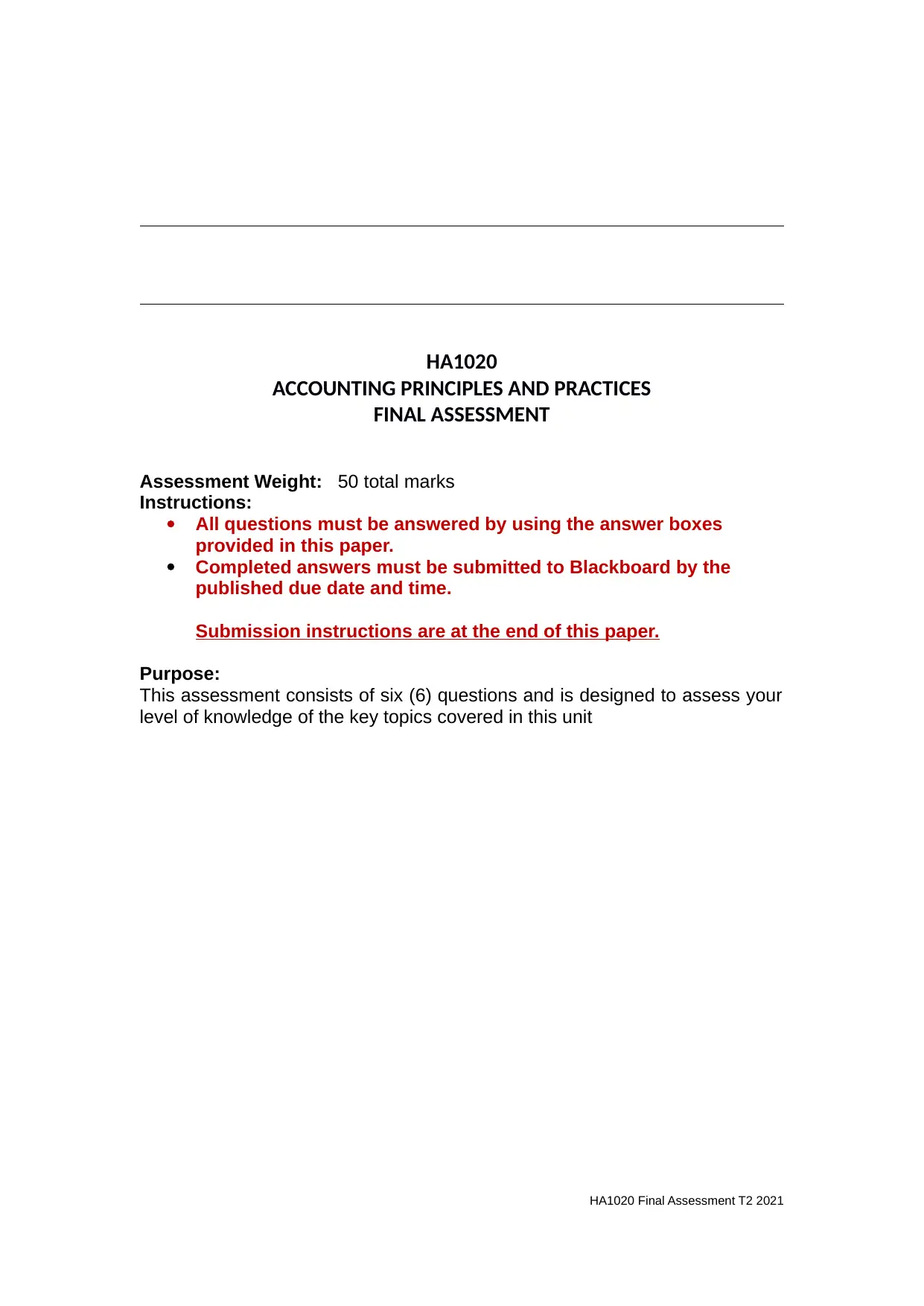
HA1020
ACCOUNTING PRINCIPLES AND PRACTICES
FINAL ASSESSMENT
Assessment Weight: 50 total marks
Instructions:
All questions must be answered by using the answer boxes
provided in this paper.
Completed answers must be submitted to Blackboard by the
published due date and time.
Submission instructions are at the end of this paper.
Purpose:
This assessment consists of six (6) questions and is designed to assess your
level of knowledge of the key topics covered in this unit
HA1020 Final Assessment T2 2021
ACCOUNTING PRINCIPLES AND PRACTICES
FINAL ASSESSMENT
Assessment Weight: 50 total marks
Instructions:
All questions must be answered by using the answer boxes
provided in this paper.
Completed answers must be submitted to Blackboard by the
published due date and time.
Submission instructions are at the end of this paper.
Purpose:
This assessment consists of six (6) questions and is designed to assess your
level of knowledge of the key topics covered in this unit
HA1020 Final Assessment T2 2021
Paraphrase This Document
Need a fresh take? Get an instant paraphrase of this document with our AI Paraphraser
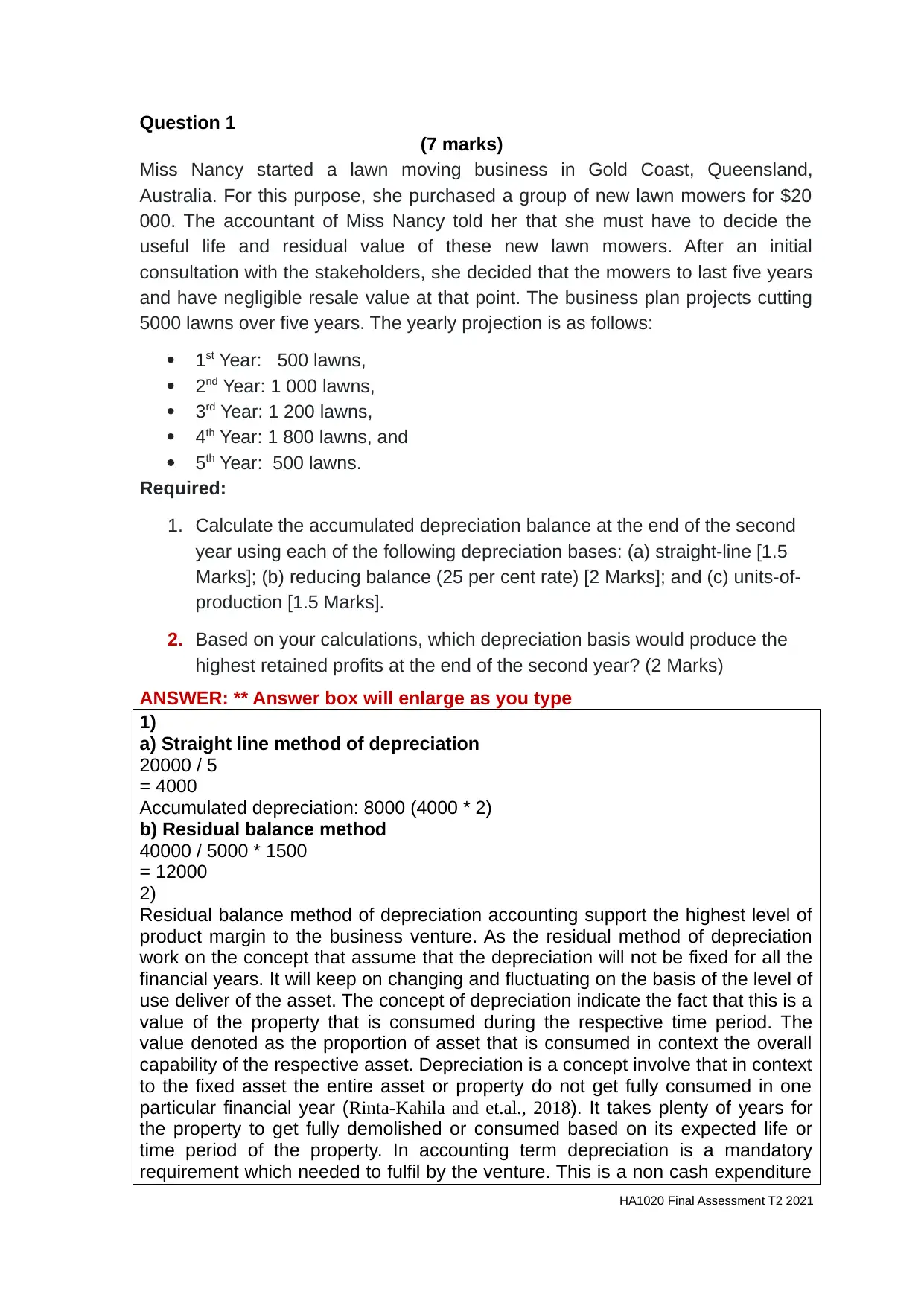
Question 1
(7 marks)
Miss Nancy started a lawn moving business in Gold Coast, Queensland,
Australia. For this purpose, she purchased a group of new lawn mowers for $20
000. The accountant of Miss Nancy told her that she must have to decide the
useful life and residual value of these new lawn mowers. After an initial
consultation with the stakeholders, she decided that the mowers to last five years
and have negligible resale value at that point. The business plan projects cutting
5000 lawns over five years. The yearly projection is as follows:
1st Year: 500 lawns,
2nd Year: 1 000 lawns,
3rd Year: 1 200 lawns,
4th Year: 1 800 lawns, and
5th Year: 500 lawns.
Required:
1. Calculate the accumulated depreciation balance at the end of the second
year using each of the following depreciation bases: (a) straight-line [1.5
Marks]; (b) reducing balance (25 per cent rate) [2 Marks]; and (c) units-of-
production [1.5 Marks].
2. Based on your calculations, which depreciation basis would produce the
highest retained profits at the end of the second year? (2 Marks)
ANSWER: ** Answer box will enlarge as you type
1)
a) Straight line method of depreciation
20000 / 5
= 4000
Accumulated depreciation: 8000 (4000 * 2)
b) Residual balance method
40000 / 5000 * 1500
= 12000
2)
Residual balance method of depreciation accounting support the highest level of
product margin to the business venture. As the residual method of depreciation
work on the concept that assume that the depreciation will not be fixed for all the
financial years. It will keep on changing and fluctuating on the basis of the level of
use deliver of the asset. The concept of depreciation indicate the fact that this is a
value of the property that is consumed during the respective time period. The
value denoted as the proportion of asset that is consumed in context the overall
capability of the respective asset. Depreciation is a concept involve that in context
to the fixed asset the entire asset or property do not get fully consumed in one
particular financial year (Rinta-Kahila and et.al., 2018). It takes plenty of years for
the property to get fully demolished or consumed based on its expected life or
time period of the property. In accounting term depreciation is a mandatory
requirement which needed to fulfil by the venture. This is a non cash expenditure
HA1020 Final Assessment T2 2021
(7 marks)
Miss Nancy started a lawn moving business in Gold Coast, Queensland,
Australia. For this purpose, she purchased a group of new lawn mowers for $20
000. The accountant of Miss Nancy told her that she must have to decide the
useful life and residual value of these new lawn mowers. After an initial
consultation with the stakeholders, she decided that the mowers to last five years
and have negligible resale value at that point. The business plan projects cutting
5000 lawns over five years. The yearly projection is as follows:
1st Year: 500 lawns,
2nd Year: 1 000 lawns,
3rd Year: 1 200 lawns,
4th Year: 1 800 lawns, and
5th Year: 500 lawns.
Required:
1. Calculate the accumulated depreciation balance at the end of the second
year using each of the following depreciation bases: (a) straight-line [1.5
Marks]; (b) reducing balance (25 per cent rate) [2 Marks]; and (c) units-of-
production [1.5 Marks].
2. Based on your calculations, which depreciation basis would produce the
highest retained profits at the end of the second year? (2 Marks)
ANSWER: ** Answer box will enlarge as you type
1)
a) Straight line method of depreciation
20000 / 5
= 4000
Accumulated depreciation: 8000 (4000 * 2)
b) Residual balance method
40000 / 5000 * 1500
= 12000
2)
Residual balance method of depreciation accounting support the highest level of
product margin to the business venture. As the residual method of depreciation
work on the concept that assume that the depreciation will not be fixed for all the
financial years. It will keep on changing and fluctuating on the basis of the level of
use deliver of the asset. The concept of depreciation indicate the fact that this is a
value of the property that is consumed during the respective time period. The
value denoted as the proportion of asset that is consumed in context the overall
capability of the respective asset. Depreciation is a concept involve that in context
to the fixed asset the entire asset or property do not get fully consumed in one
particular financial year (Rinta-Kahila and et.al., 2018). It takes plenty of years for
the property to get fully demolished or consumed based on its expected life or
time period of the property. In accounting term depreciation is a mandatory
requirement which needed to fulfil by the venture. This is a non cash expenditure
HA1020 Final Assessment T2 2021
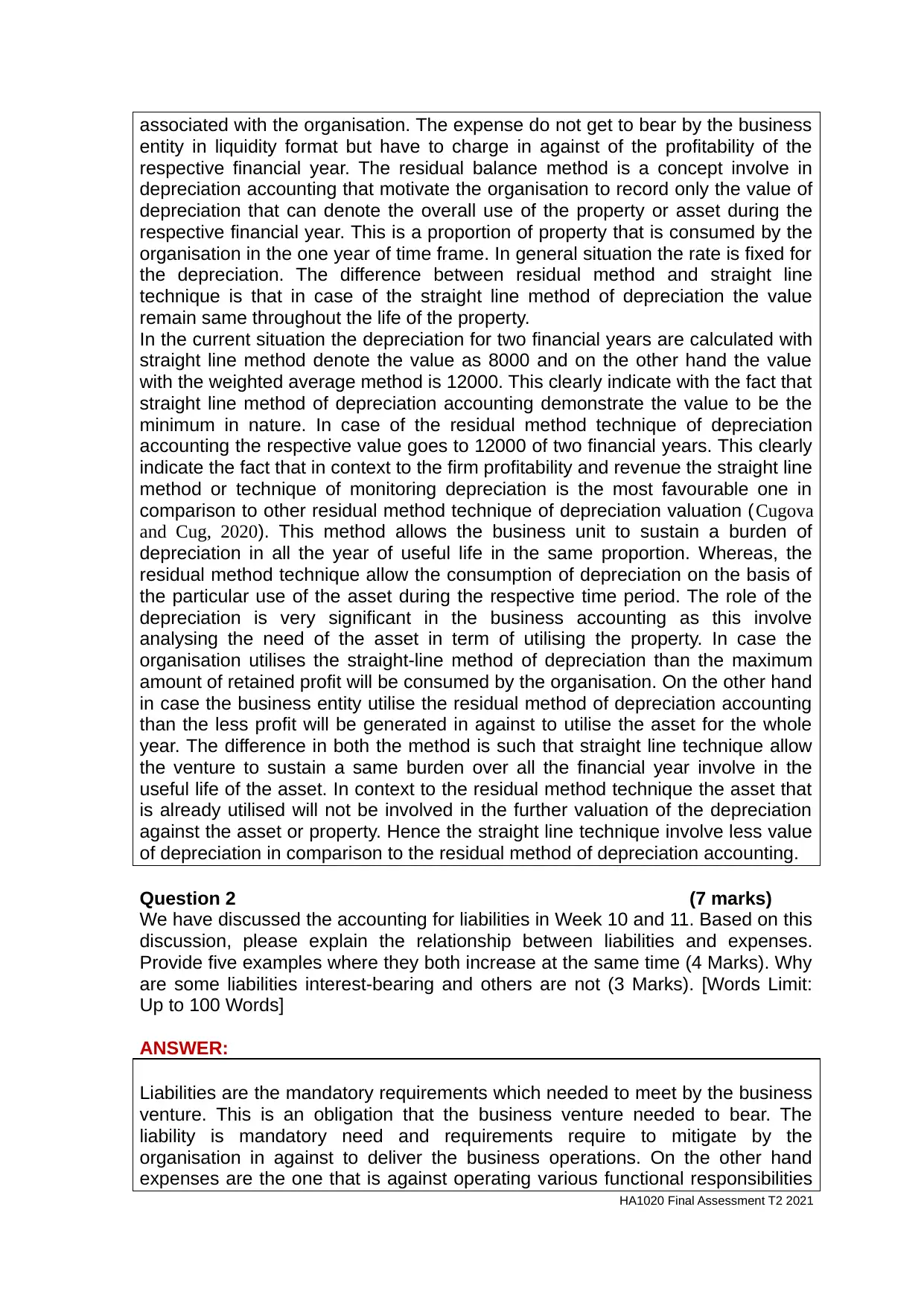
associated with the organisation. The expense do not get to bear by the business
entity in liquidity format but have to charge in against of the profitability of the
respective financial year. The residual balance method is a concept involve in
depreciation accounting that motivate the organisation to record only the value of
depreciation that can denote the overall use of the property or asset during the
respective financial year. This is a proportion of property that is consumed by the
organisation in the one year of time frame. In general situation the rate is fixed for
the depreciation. The difference between residual method and straight line
technique is that in case of the straight line method of depreciation the value
remain same throughout the life of the property.
In the current situation the depreciation for two financial years are calculated with
straight line method denote the value as 8000 and on the other hand the value
with the weighted average method is 12000. This clearly indicate with the fact that
straight line method of depreciation accounting demonstrate the value to be the
minimum in nature. In case of the residual method technique of depreciation
accounting the respective value goes to 12000 of two financial years. This clearly
indicate the fact that in context to the firm profitability and revenue the straight line
method or technique of monitoring depreciation is the most favourable one in
comparison to other residual method technique of depreciation valuation (Cugova
and Cug, 2020). This method allows the business unit to sustain a burden of
depreciation in all the year of useful life in the same proportion. Whereas, the
residual method technique allow the consumption of depreciation on the basis of
the particular use of the asset during the respective time period. The role of the
depreciation is very significant in the business accounting as this involve
analysing the need of the asset in term of utilising the property. In case the
organisation utilises the straight-line method of depreciation than the maximum
amount of retained profit will be consumed by the organisation. On the other hand
in case the business entity utilise the residual method of depreciation accounting
than the less profit will be generated in against to utilise the asset for the whole
year. The difference in both the method is such that straight line technique allow
the venture to sustain a same burden over all the financial year involve in the
useful life of the asset. In context to the residual method technique the asset that
is already utilised will not be involved in the further valuation of the depreciation
against the asset or property. Hence the straight line technique involve less value
of depreciation in comparison to the residual method of depreciation accounting.
Question 2 (7 marks)
We have discussed the accounting for liabilities in Week 10 and 11. Based on this
discussion, please explain the relationship between liabilities and expenses.
Provide five examples where they both increase at the same time (4 Marks). Why
are some liabilities interest-bearing and others are not (3 Marks). [Words Limit:
Up to 100 Words]
ANSWER:
Liabilities are the mandatory requirements which needed to meet by the business
venture. This is an obligation that the business venture needed to bear. The
liability is mandatory need and requirements require to mitigate by the
organisation in against to deliver the business operations. On the other hand
expenses are the one that is against operating various functional responsibilities
HA1020 Final Assessment T2 2021
entity in liquidity format but have to charge in against of the profitability of the
respective financial year. The residual balance method is a concept involve in
depreciation accounting that motivate the organisation to record only the value of
depreciation that can denote the overall use of the property or asset during the
respective financial year. This is a proportion of property that is consumed by the
organisation in the one year of time frame. In general situation the rate is fixed for
the depreciation. The difference between residual method and straight line
technique is that in case of the straight line method of depreciation the value
remain same throughout the life of the property.
In the current situation the depreciation for two financial years are calculated with
straight line method denote the value as 8000 and on the other hand the value
with the weighted average method is 12000. This clearly indicate with the fact that
straight line method of depreciation accounting demonstrate the value to be the
minimum in nature. In case of the residual method technique of depreciation
accounting the respective value goes to 12000 of two financial years. This clearly
indicate the fact that in context to the firm profitability and revenue the straight line
method or technique of monitoring depreciation is the most favourable one in
comparison to other residual method technique of depreciation valuation (Cugova
and Cug, 2020). This method allows the business unit to sustain a burden of
depreciation in all the year of useful life in the same proportion. Whereas, the
residual method technique allow the consumption of depreciation on the basis of
the particular use of the asset during the respective time period. The role of the
depreciation is very significant in the business accounting as this involve
analysing the need of the asset in term of utilising the property. In case the
organisation utilises the straight-line method of depreciation than the maximum
amount of retained profit will be consumed by the organisation. On the other hand
in case the business entity utilise the residual method of depreciation accounting
than the less profit will be generated in against to utilise the asset for the whole
year. The difference in both the method is such that straight line technique allow
the venture to sustain a same burden over all the financial year involve in the
useful life of the asset. In context to the residual method technique the asset that
is already utilised will not be involved in the further valuation of the depreciation
against the asset or property. Hence the straight line technique involve less value
of depreciation in comparison to the residual method of depreciation accounting.
Question 2 (7 marks)
We have discussed the accounting for liabilities in Week 10 and 11. Based on this
discussion, please explain the relationship between liabilities and expenses.
Provide five examples where they both increase at the same time (4 Marks). Why
are some liabilities interest-bearing and others are not (3 Marks). [Words Limit:
Up to 100 Words]
ANSWER:
Liabilities are the mandatory requirements which needed to meet by the business
venture. This is an obligation that the business venture needed to bear. The
liability is mandatory need and requirements require to mitigate by the
organisation in against to deliver the business operations. On the other hand
expenses are the one that is against operating various functional responsibilities
HA1020 Final Assessment T2 2021
⊘ This is a preview!⊘
Do you want full access?
Subscribe today to unlock all pages.

Trusted by 1+ million students worldwide
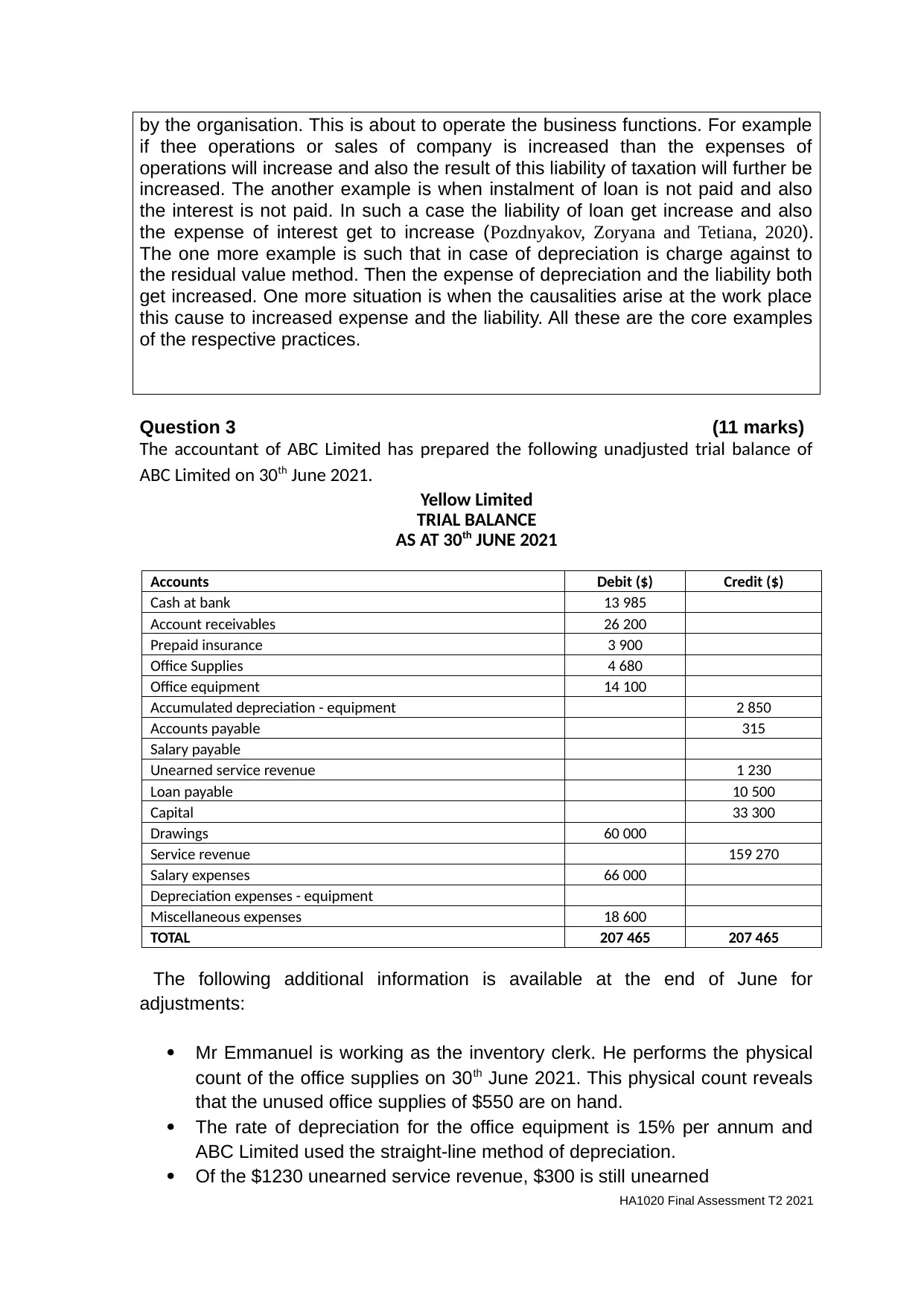
by the organisation. This is about to operate the business functions. For example
if thee operations or sales of company is increased than the expenses of
operations will increase and also the result of this liability of taxation will further be
increased. The another example is when instalment of loan is not paid and also
the interest is not paid. In such a case the liability of loan get increase and also
the expense of interest get to increase (Pozdnyakov, Zoryana and Tetiana, 2020).
The one more example is such that in case of depreciation is charge against to
the residual value method. Then the expense of depreciation and the liability both
get increased. One more situation is when the causalities arise at the work place
this cause to increased expense and the liability. All these are the core examples
of the respective practices.
Question 3 (11 marks)
The accountant of ABC Limited has prepared the following unadjusted trial balance of
ABC Limited on 30th June 2021.
Yellow Limited
TRIAL BALANCE
AS AT 30th JUNE 2021
Accounts Debit ($) Credit ($)
Cash at bank 13 985
Account receivables 26 200
Prepaid insurance 3 900
Office Supplies 4 680
Office equipment 14 100
Accumulated depreciation - equipment 2 850
Accounts payable 315
Salary payable
Unearned service revenue 1 230
Loan payable 10 500
Capital 33 300
Drawings 60 000
Service revenue 159 270
Salary expenses 66 000
Depreciation expenses - equipment
Miscellaneous expenses 18 600
TOTAL 207 465 207 465
The following additional information is available at the end of June for
adjustments:
Mr Emmanuel is working as the inventory clerk. He performs the physical
count of the office supplies on 30th June 2021. This physical count reveals
that the unused office supplies of $550 are on hand.
The rate of depreciation for the office equipment is 15% per annum and
ABC Limited used the straight-line method of depreciation.
Of the $1230 unearned service revenue, $300 is still unearned
HA1020 Final Assessment T2 2021
if thee operations or sales of company is increased than the expenses of
operations will increase and also the result of this liability of taxation will further be
increased. The another example is when instalment of loan is not paid and also
the interest is not paid. In such a case the liability of loan get increase and also
the expense of interest get to increase (Pozdnyakov, Zoryana and Tetiana, 2020).
The one more example is such that in case of depreciation is charge against to
the residual value method. Then the expense of depreciation and the liability both
get increased. One more situation is when the causalities arise at the work place
this cause to increased expense and the liability. All these are the core examples
of the respective practices.
Question 3 (11 marks)
The accountant of ABC Limited has prepared the following unadjusted trial balance of
ABC Limited on 30th June 2021.
Yellow Limited
TRIAL BALANCE
AS AT 30th JUNE 2021
Accounts Debit ($) Credit ($)
Cash at bank 13 985
Account receivables 26 200
Prepaid insurance 3 900
Office Supplies 4 680
Office equipment 14 100
Accumulated depreciation - equipment 2 850
Accounts payable 315
Salary payable
Unearned service revenue 1 230
Loan payable 10 500
Capital 33 300
Drawings 60 000
Service revenue 159 270
Salary expenses 66 000
Depreciation expenses - equipment
Miscellaneous expenses 18 600
TOTAL 207 465 207 465
The following additional information is available at the end of June for
adjustments:
Mr Emmanuel is working as the inventory clerk. He performs the physical
count of the office supplies on 30th June 2021. This physical count reveals
that the unused office supplies of $550 are on hand.
The rate of depreciation for the office equipment is 15% per annum and
ABC Limited used the straight-line method of depreciation.
Of the $1230 unearned service revenue, $300 is still unearned
HA1020 Final Assessment T2 2021
Paraphrase This Document
Need a fresh take? Get an instant paraphrase of this document with our AI Paraphraser
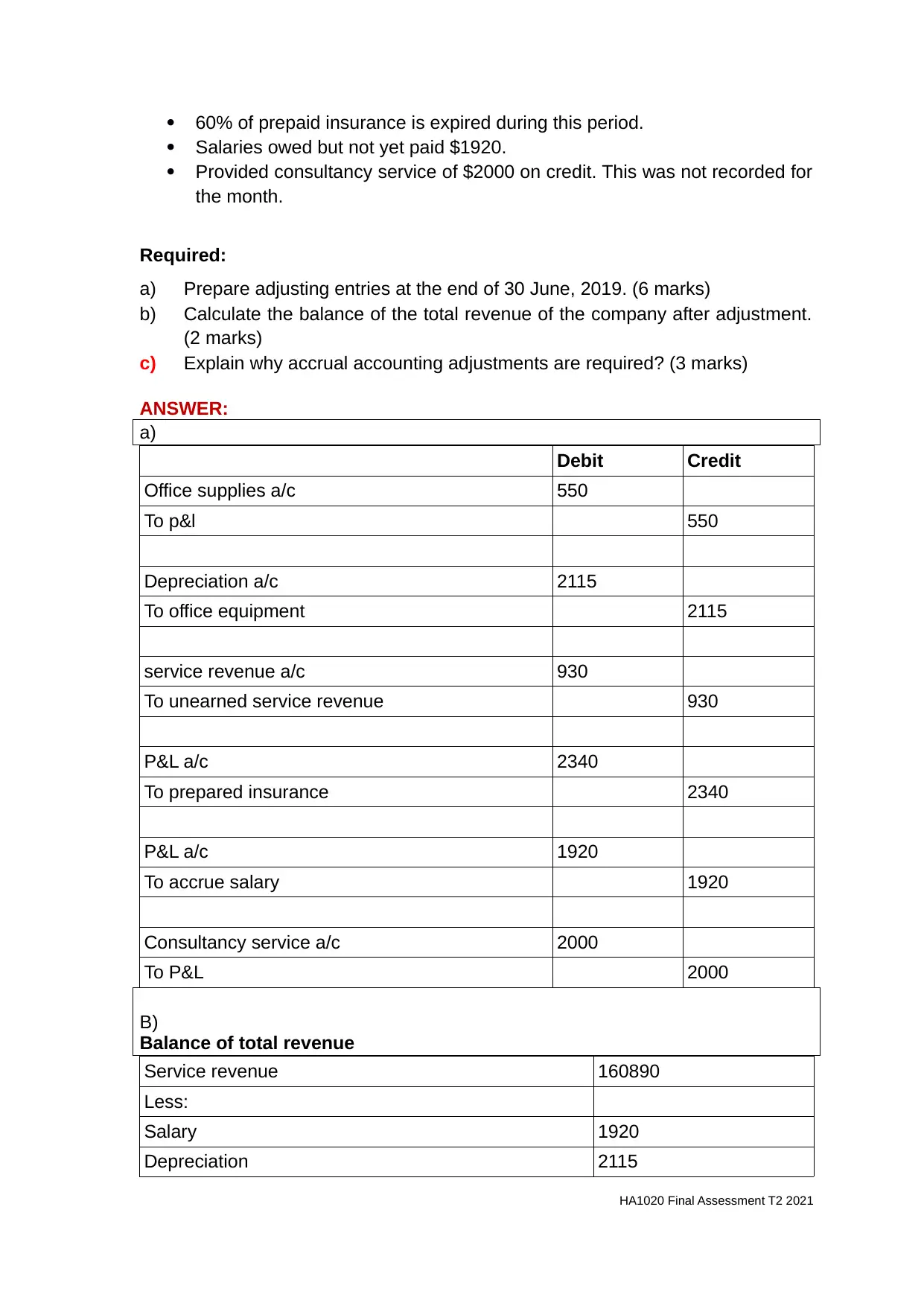
60% of prepaid insurance is expired during this period.
Salaries owed but not yet paid $1920.
Provided consultancy service of $2000 on credit. This was not recorded for
the month.
Required:
a) Prepare adjusting entries at the end of 30 June, 2019. (6 marks)
b) Calculate the balance of the total revenue of the company after adjustment.
(2 marks)
c) Explain why accrual accounting adjustments are required? (3 marks)
ANSWER:
a)
Debit Credit
Office supplies a/c 550
To p&l 550
Depreciation a/c 2115
To office equipment 2115
service revenue a/c 930
To unearned service revenue 930
P&L a/c 2340
To prepared insurance 2340
P&L a/c 1920
To accrue salary 1920
Consultancy service a/c 2000
To P&L 2000
B)
Balance of total revenue
Service revenue 160890
Less:
Salary 1920
Depreciation 2115
HA1020 Final Assessment T2 2021
Salaries owed but not yet paid $1920.
Provided consultancy service of $2000 on credit. This was not recorded for
the month.
Required:
a) Prepare adjusting entries at the end of 30 June, 2019. (6 marks)
b) Calculate the balance of the total revenue of the company after adjustment.
(2 marks)
c) Explain why accrual accounting adjustments are required? (3 marks)
ANSWER:
a)
Debit Credit
Office supplies a/c 550
To p&l 550
Depreciation a/c 2115
To office equipment 2115
service revenue a/c 930
To unearned service revenue 930
P&L a/c 2340
To prepared insurance 2340
P&L a/c 1920
To accrue salary 1920
Consultancy service a/c 2000
To P&L 2000
B)
Balance of total revenue
Service revenue 160890
Less:
Salary 1920
Depreciation 2115
HA1020 Final Assessment T2 2021
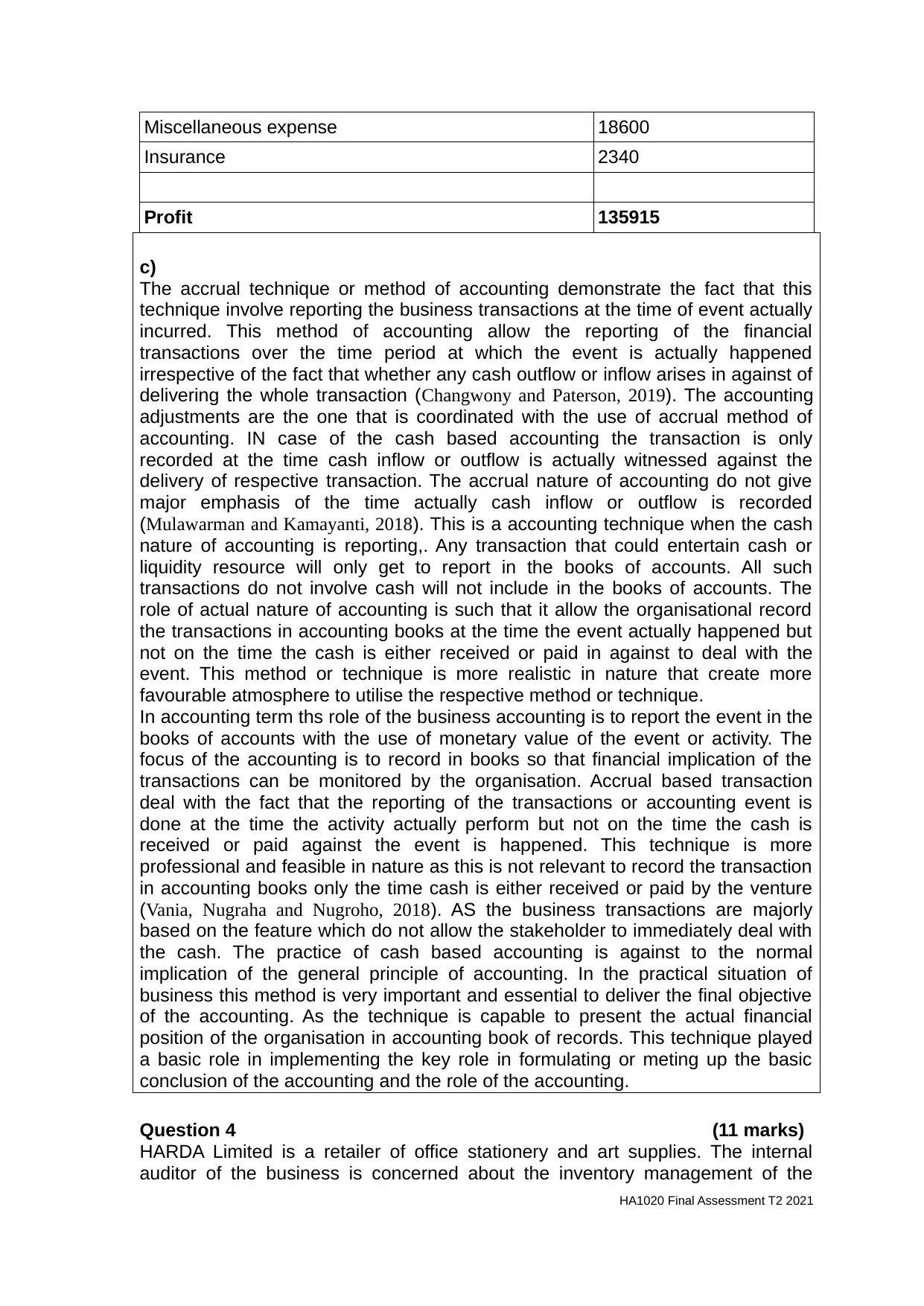
Miscellaneous expense 18600
Insurance 2340
Profit 135915
c)
The accrual technique or method of accounting demonstrate the fact that this
technique involve reporting the business transactions at the time of event actually
incurred. This method of accounting allow the reporting of the financial
transactions over the time period at which the event is actually happened
irrespective of the fact that whether any cash outflow or inflow arises in against of
delivering the whole transaction (Changwony and Paterson, 2019). The accounting
adjustments are the one that is coordinated with the use of accrual method of
accounting. IN case of the cash based accounting the transaction is only
recorded at the time cash inflow or outflow is actually witnessed against the
delivery of respective transaction. The accrual nature of accounting do not give
major emphasis of the time actually cash inflow or outflow is recorded
(Mulawarman and Kamayanti, 2018). This is a accounting technique when the cash
nature of accounting is reporting,. Any transaction that could entertain cash or
liquidity resource will only get to report in the books of accounts. All such
transactions do not involve cash will not include in the books of accounts. The
role of actual nature of accounting is such that it allow the organisational record
the transactions in accounting books at the time the event actually happened but
not on the time the cash is either received or paid in against to deal with the
event. This method or technique is more realistic in nature that create more
favourable atmosphere to utilise the respective method or technique.
In accounting term ths role of the business accounting is to report the event in the
books of accounts with the use of monetary value of the event or activity. The
focus of the accounting is to record in books so that financial implication of the
transactions can be monitored by the organisation. Accrual based transaction
deal with the fact that the reporting of the transactions or accounting event is
done at the time the activity actually perform but not on the time the cash is
received or paid against the event is happened. This technique is more
professional and feasible in nature as this is not relevant to record the transaction
in accounting books only the time cash is either received or paid by the venture
(Vania, Nugraha and Nugroho, 2018). AS the business transactions are majorly
based on the feature which do not allow the stakeholder to immediately deal with
the cash. The practice of cash based accounting is against to the normal
implication of the general principle of accounting. In the practical situation of
business this method is very important and essential to deliver the final objective
of the accounting. As the technique is capable to present the actual financial
position of the organisation in accounting book of records. This technique played
a basic role in implementing the key role in formulating or meting up the basic
conclusion of the accounting and the role of the accounting.
Question 4 (11 marks)
HARDA Limited is a retailer of office stationery and art supplies. The internal
auditor of the business is concerned about the inventory management of the
HA1020 Final Assessment T2 2021
Insurance 2340
Profit 135915
c)
The accrual technique or method of accounting demonstrate the fact that this
technique involve reporting the business transactions at the time of event actually
incurred. This method of accounting allow the reporting of the financial
transactions over the time period at which the event is actually happened
irrespective of the fact that whether any cash outflow or inflow arises in against of
delivering the whole transaction (Changwony and Paterson, 2019). The accounting
adjustments are the one that is coordinated with the use of accrual method of
accounting. IN case of the cash based accounting the transaction is only
recorded at the time cash inflow or outflow is actually witnessed against the
delivery of respective transaction. The accrual nature of accounting do not give
major emphasis of the time actually cash inflow or outflow is recorded
(Mulawarman and Kamayanti, 2018). This is a accounting technique when the cash
nature of accounting is reporting,. Any transaction that could entertain cash or
liquidity resource will only get to report in the books of accounts. All such
transactions do not involve cash will not include in the books of accounts. The
role of actual nature of accounting is such that it allow the organisational record
the transactions in accounting books at the time the event actually happened but
not on the time the cash is either received or paid in against to deal with the
event. This method or technique is more realistic in nature that create more
favourable atmosphere to utilise the respective method or technique.
In accounting term ths role of the business accounting is to report the event in the
books of accounts with the use of monetary value of the event or activity. The
focus of the accounting is to record in books so that financial implication of the
transactions can be monitored by the organisation. Accrual based transaction
deal with the fact that the reporting of the transactions or accounting event is
done at the time the activity actually perform but not on the time the cash is
received or paid against the event is happened. This technique is more
professional and feasible in nature as this is not relevant to record the transaction
in accounting books only the time cash is either received or paid by the venture
(Vania, Nugraha and Nugroho, 2018). AS the business transactions are majorly
based on the feature which do not allow the stakeholder to immediately deal with
the cash. The practice of cash based accounting is against to the normal
implication of the general principle of accounting. In the practical situation of
business this method is very important and essential to deliver the final objective
of the accounting. As the technique is capable to present the actual financial
position of the organisation in accounting book of records. This technique played
a basic role in implementing the key role in formulating or meting up the basic
conclusion of the accounting and the role of the accounting.
Question 4 (11 marks)
HARDA Limited is a retailer of office stationery and art supplies. The internal
auditor of the business is concerned about the inventory management of the
HA1020 Final Assessment T2 2021
⊘ This is a preview!⊘
Do you want full access?
Subscribe today to unlock all pages.

Trusted by 1+ million students worldwide
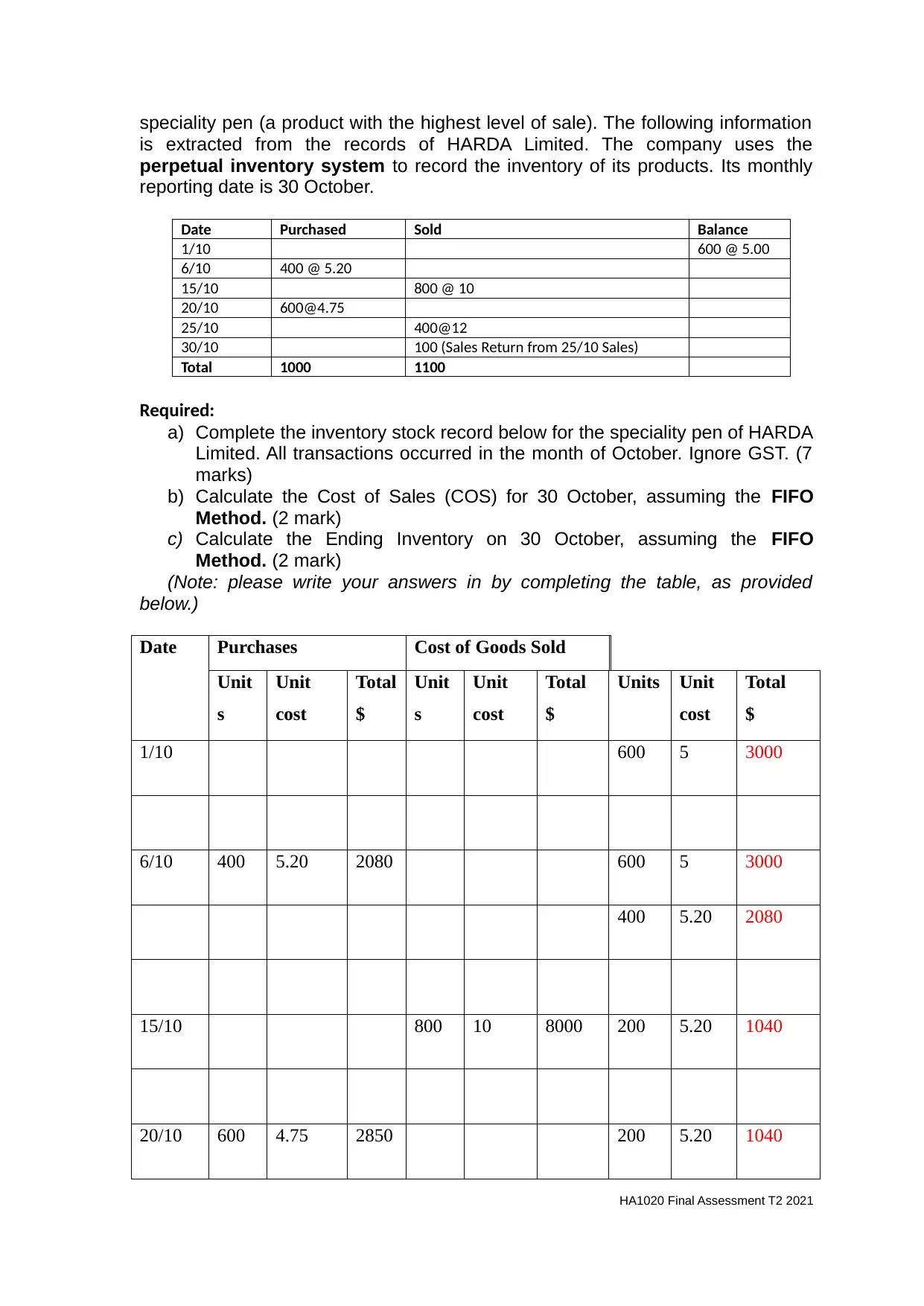
speciality pen (a product with the highest level of sale). The following information
is extracted from the records of HARDA Limited. The company uses the
perpetual inventory system to record the inventory of its products. Its monthly
reporting date is 30 October.
Date Purchased Sold Balance
1/10 600 @ 5.00
6/10 400 @ 5.20
15/10 800 @ 10
20/10 600@4.75
25/10 400@12
30/10 100 (Sales Return from 25/10 Sales)
Total 1000 1100
Required:
a) Complete the inventory stock record below for the speciality pen of HARDA
Limited. All transactions occurred in the month of October. Ignore GST. (7
marks)
b) Calculate the Cost of Sales (COS) for 30 October, assuming the FIFO
Method. (2 mark)
c) Calculate the Ending Inventory on 30 October, assuming the FIFO
Method. (2 mark)
(Note: please write your answers in by completing the table, as provided
below.)
Date Purchases Cost of Goods Sold
Unit
s
Unit
cost
Total
$
Unit
s
Unit
cost
Total
$
Units Unit
cost
Total
$
1/10 600 5 3000
6/10 400 5.20 2080 600 5 3000
400 5.20 2080
15/10 800 10 8000 200 5.20 1040
20/10 600 4.75 2850 200 5.20 1040
HA1020 Final Assessment T2 2021
is extracted from the records of HARDA Limited. The company uses the
perpetual inventory system to record the inventory of its products. Its monthly
reporting date is 30 October.
Date Purchased Sold Balance
1/10 600 @ 5.00
6/10 400 @ 5.20
15/10 800 @ 10
20/10 600@4.75
25/10 400@12
30/10 100 (Sales Return from 25/10 Sales)
Total 1000 1100
Required:
a) Complete the inventory stock record below for the speciality pen of HARDA
Limited. All transactions occurred in the month of October. Ignore GST. (7
marks)
b) Calculate the Cost of Sales (COS) for 30 October, assuming the FIFO
Method. (2 mark)
c) Calculate the Ending Inventory on 30 October, assuming the FIFO
Method. (2 mark)
(Note: please write your answers in by completing the table, as provided
below.)
Date Purchases Cost of Goods Sold
Unit
s
Unit
cost
Total
$
Unit
s
Unit
cost
Total
$
Units Unit
cost
Total
$
1/10 600 5 3000
6/10 400 5.20 2080 600 5 3000
400 5.20 2080
15/10 800 10 8000 200 5.20 1040
20/10 600 4.75 2850 200 5.20 1040
HA1020 Final Assessment T2 2021
Paraphrase This Document
Need a fresh take? Get an instant paraphrase of this document with our AI Paraphraser
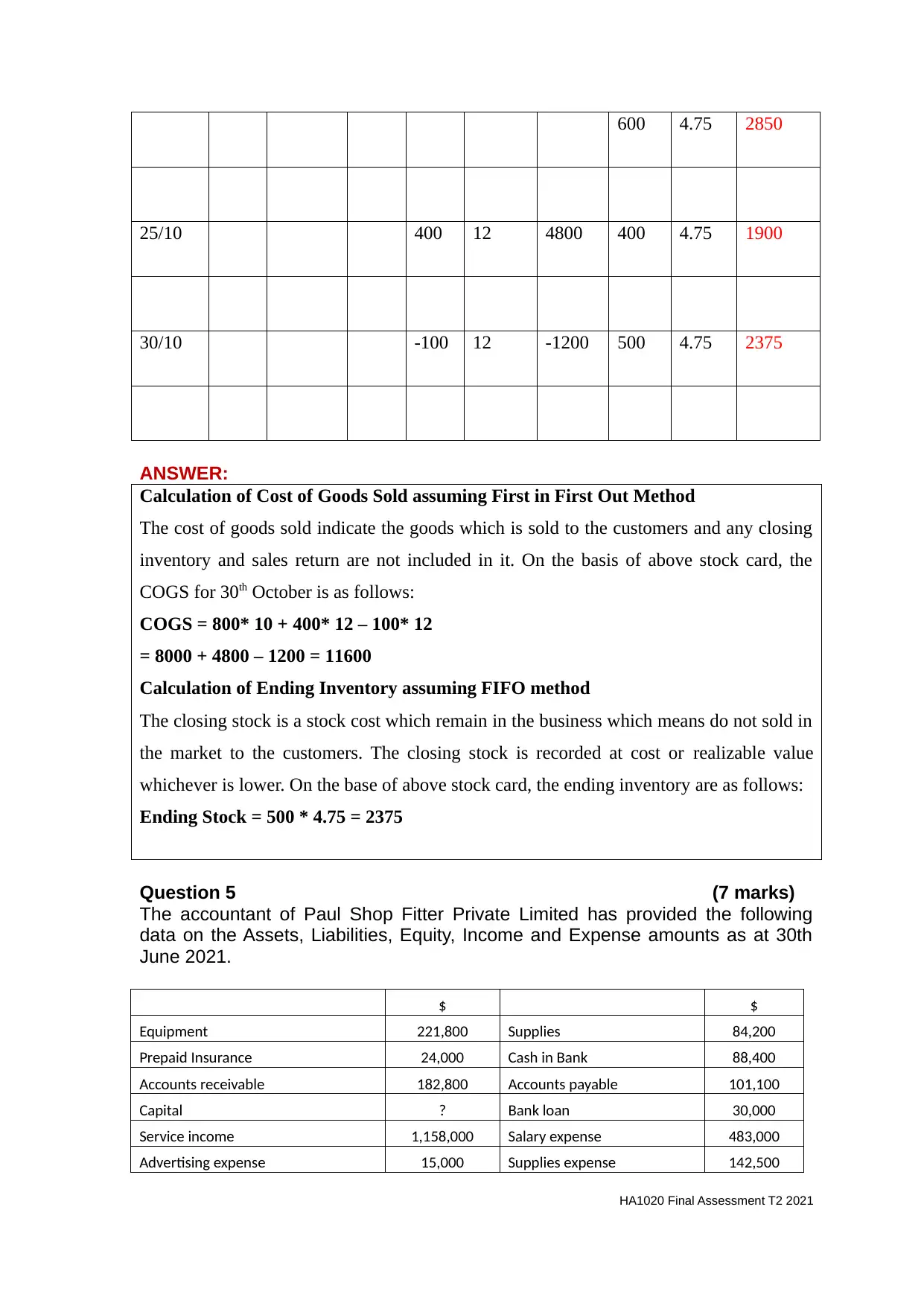
600 4.75 2850
25/10 400 12 4800 400 4.75 1900
30/10 -100 12 -1200 500 4.75 2375
ANSWER:
Calculation of Cost of Goods Sold assuming First in First Out Method
The cost of goods sold indicate the goods which is sold to the customers and any closing
inventory and sales return are not included in it. On the basis of above stock card, the
COGS for 30th October is as follows:
COGS = 800* 10 + 400* 12 – 100* 12
= 8000 + 4800 – 1200 = 11600
Calculation of Ending Inventory assuming FIFO method
The closing stock is a stock cost which remain in the business which means do not sold in
the market to the customers. The closing stock is recorded at cost or realizable value
whichever is lower. On the base of above stock card, the ending inventory are as follows:
Ending Stock = 500 * 4.75 = 2375
Question 5 (7 marks)
The accountant of Paul Shop Fitter Private Limited has provided the following
data on the Assets, Liabilities, Equity, Income and Expense amounts as at 30th
June 2021.
$ $
Equipment 221,800 Supplies 84,200
Prepaid Insurance 24,000 Cash in Bank 88,400
Accounts receivable 182,800 Accounts payable 101,100
Capital ? Bank loan 30,000
Service income 1,158,000 Salary expense 483,000
Advertising expense 15,000 Supplies expense 142,500
HA1020 Final Assessment T2 2021
25/10 400 12 4800 400 4.75 1900
30/10 -100 12 -1200 500 4.75 2375
ANSWER:
Calculation of Cost of Goods Sold assuming First in First Out Method
The cost of goods sold indicate the goods which is sold to the customers and any closing
inventory and sales return are not included in it. On the basis of above stock card, the
COGS for 30th October is as follows:
COGS = 800* 10 + 400* 12 – 100* 12
= 8000 + 4800 – 1200 = 11600
Calculation of Ending Inventory assuming FIFO method
The closing stock is a stock cost which remain in the business which means do not sold in
the market to the customers. The closing stock is recorded at cost or realizable value
whichever is lower. On the base of above stock card, the ending inventory are as follows:
Ending Stock = 500 * 4.75 = 2375
Question 5 (7 marks)
The accountant of Paul Shop Fitter Private Limited has provided the following
data on the Assets, Liabilities, Equity, Income and Expense amounts as at 30th
June 2021.
$ $
Equipment 221,800 Supplies 84,200
Prepaid Insurance 24,000 Cash in Bank 88,400
Accounts receivable 182,800 Accounts payable 101,100
Capital ? Bank loan 30,000
Service income 1,158,000 Salary expense 483,000
Advertising expense 15,000 Supplies expense 142,500
HA1020 Final Assessment T2 2021
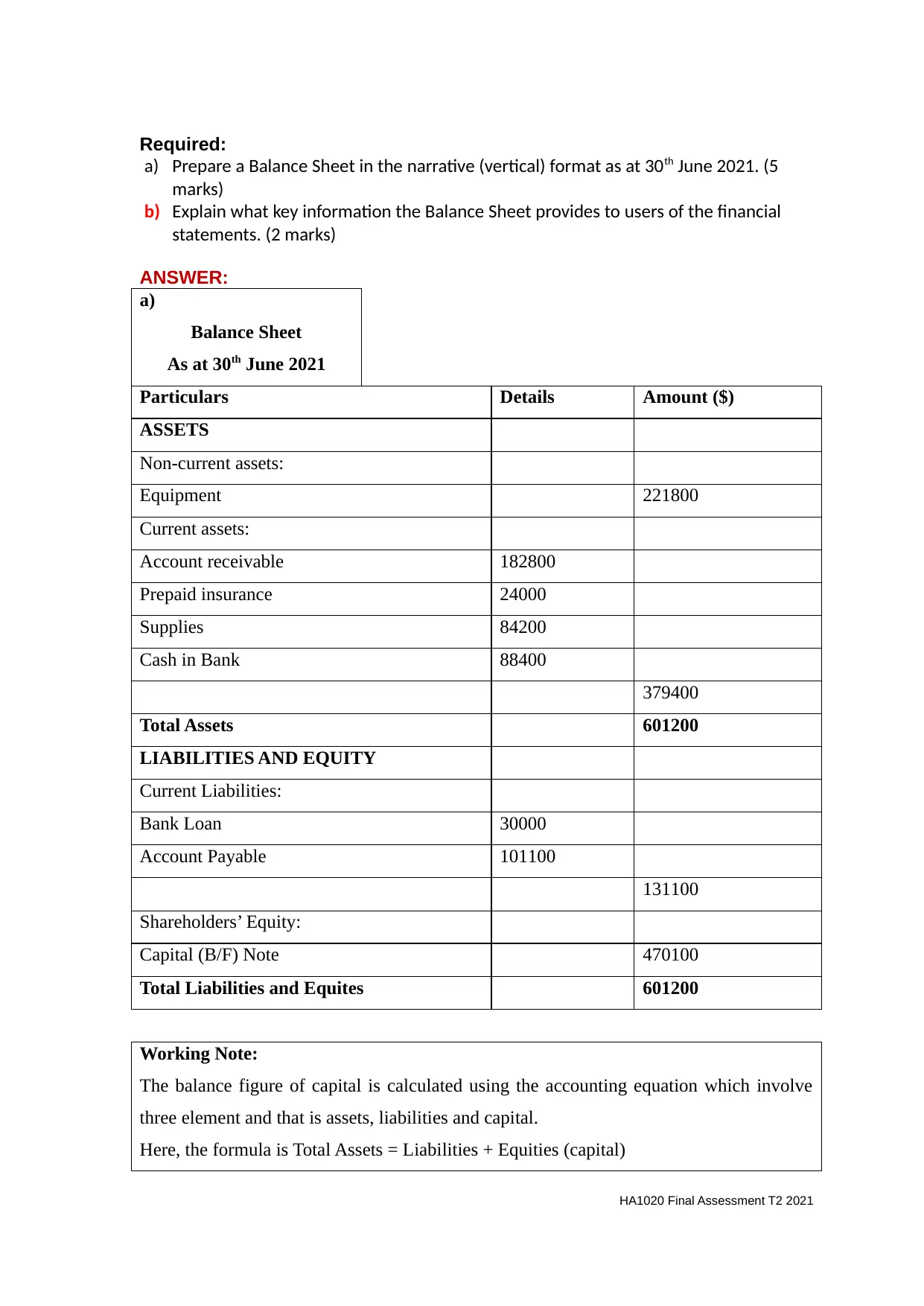
Required:
a) Prepare a Balance Sheet in the narrative (vertical) format as at 30th June 2021. (5
marks)
b) Explain what key information the Balance Sheet provides to users of the financial
statements. (2 marks)
ANSWER:
a)
Balance Sheet
As at 30th June 2021
Particulars Details Amount ($)
ASSETS
Non-current assets:
Equipment 221800
Current assets:
Account receivable 182800
Prepaid insurance 24000
Supplies 84200
Cash in Bank 88400
379400
Total Assets 601200
LIABILITIES AND EQUITY
Current Liabilities:
Bank Loan 30000
Account Payable 101100
131100
Shareholders’ Equity:
Capital (B/F) Note 470100
Total Liabilities and Equites 601200
Working Note:
The balance figure of capital is calculated using the accounting equation which involve
three element and that is assets, liabilities and capital.
Here, the formula is Total Assets = Liabilities + Equities (capital)
HA1020 Final Assessment T2 2021
a) Prepare a Balance Sheet in the narrative (vertical) format as at 30th June 2021. (5
marks)
b) Explain what key information the Balance Sheet provides to users of the financial
statements. (2 marks)
ANSWER:
a)
Balance Sheet
As at 30th June 2021
Particulars Details Amount ($)
ASSETS
Non-current assets:
Equipment 221800
Current assets:
Account receivable 182800
Prepaid insurance 24000
Supplies 84200
Cash in Bank 88400
379400
Total Assets 601200
LIABILITIES AND EQUITY
Current Liabilities:
Bank Loan 30000
Account Payable 101100
131100
Shareholders’ Equity:
Capital (B/F) Note 470100
Total Liabilities and Equites 601200
Working Note:
The balance figure of capital is calculated using the accounting equation which involve
three element and that is assets, liabilities and capital.
Here, the formula is Total Assets = Liabilities + Equities (capital)
HA1020 Final Assessment T2 2021
⊘ This is a preview!⊘
Do you want full access?
Subscribe today to unlock all pages.

Trusted by 1+ million students worldwide

b)
The key information provided by company’s balance sheet to the users of financial
statement are as follows:
Management of the company:
The balance sheet (BS) states the operational and financial management of the
company along with its debt issuances, dividend, capital expenditures etc. This helps the
users to identify that whether the company able to generate enough cash flows for their
smooth functioning of business or not. The management of the company generally
required the key information such as debt funding status, liquidity situation assessment,
trade receivable status, investment made in assets etc. This information is available in the
balance sheet of the company (Ševkušić, 2018). The working capital cycle of the
company is also measure through the financial position statement information. On this
basis, the company can adopt appropriate steps and strategy to improve this operating
cycle. Not only that, the user such as management also need to analyse the availability of
funds for the future expansion. The information related to availability of funds is shown in
the Cash and Bank balance item of current assets of balance sheet. That’s why it is stated
that BS has the large purpose for the management of the company because of the key
information it provided to the company. Along with that this also helpful for identifying
the investors of the company that the balance sheet is manipulated by the company or not
in order to show more profit and positive liquidity performance. This problem is identified
using BS.
Potential Investors of the company:
The key information such as earning available for equity shareholders, equity
shares, debts funds etc. of the balance sheet and other financial statement are use by the
investors of the company. They use this information to identify and analyse the financial
soundness of the company (Kausar and Lennox, 2017). For this, the uses the information
and data such as trends of the previous years and on that basis analyse whether investing
in such a company is profitable for them or not. Not only that, they also able to
understand the future potential growth of the company. The balance sheet specifies the
change in shareholders equity from one year to second year which further state that
whether company has issued more shares or buyback it for changing their capital
HA1020 Final Assessment T2 2021
The key information provided by company’s balance sheet to the users of financial
statement are as follows:
Management of the company:
The balance sheet (BS) states the operational and financial management of the
company along with its debt issuances, dividend, capital expenditures etc. This helps the
users to identify that whether the company able to generate enough cash flows for their
smooth functioning of business or not. The management of the company generally
required the key information such as debt funding status, liquidity situation assessment,
trade receivable status, investment made in assets etc. This information is available in the
balance sheet of the company (Ševkušić, 2018). The working capital cycle of the
company is also measure through the financial position statement information. On this
basis, the company can adopt appropriate steps and strategy to improve this operating
cycle. Not only that, the user such as management also need to analyse the availability of
funds for the future expansion. The information related to availability of funds is shown in
the Cash and Bank balance item of current assets of balance sheet. That’s why it is stated
that BS has the large purpose for the management of the company because of the key
information it provided to the company. Along with that this also helpful for identifying
the investors of the company that the balance sheet is manipulated by the company or not
in order to show more profit and positive liquidity performance. This problem is identified
using BS.
Potential Investors of the company:
The key information such as earning available for equity shareholders, equity
shares, debts funds etc. of the balance sheet and other financial statement are use by the
investors of the company. They use this information to identify and analyse the financial
soundness of the company (Kausar and Lennox, 2017). For this, the uses the information
and data such as trends of the previous years and on that basis analyse whether investing
in such a company is profitable for them or not. Not only that, they also able to
understand the future potential growth of the company. The balance sheet specifies the
change in shareholders equity from one year to second year which further state that
whether company has issued more shares or buyback it for changing their capital
HA1020 Final Assessment T2 2021
Paraphrase This Document
Need a fresh take? Get an instant paraphrase of this document with our AI Paraphraser
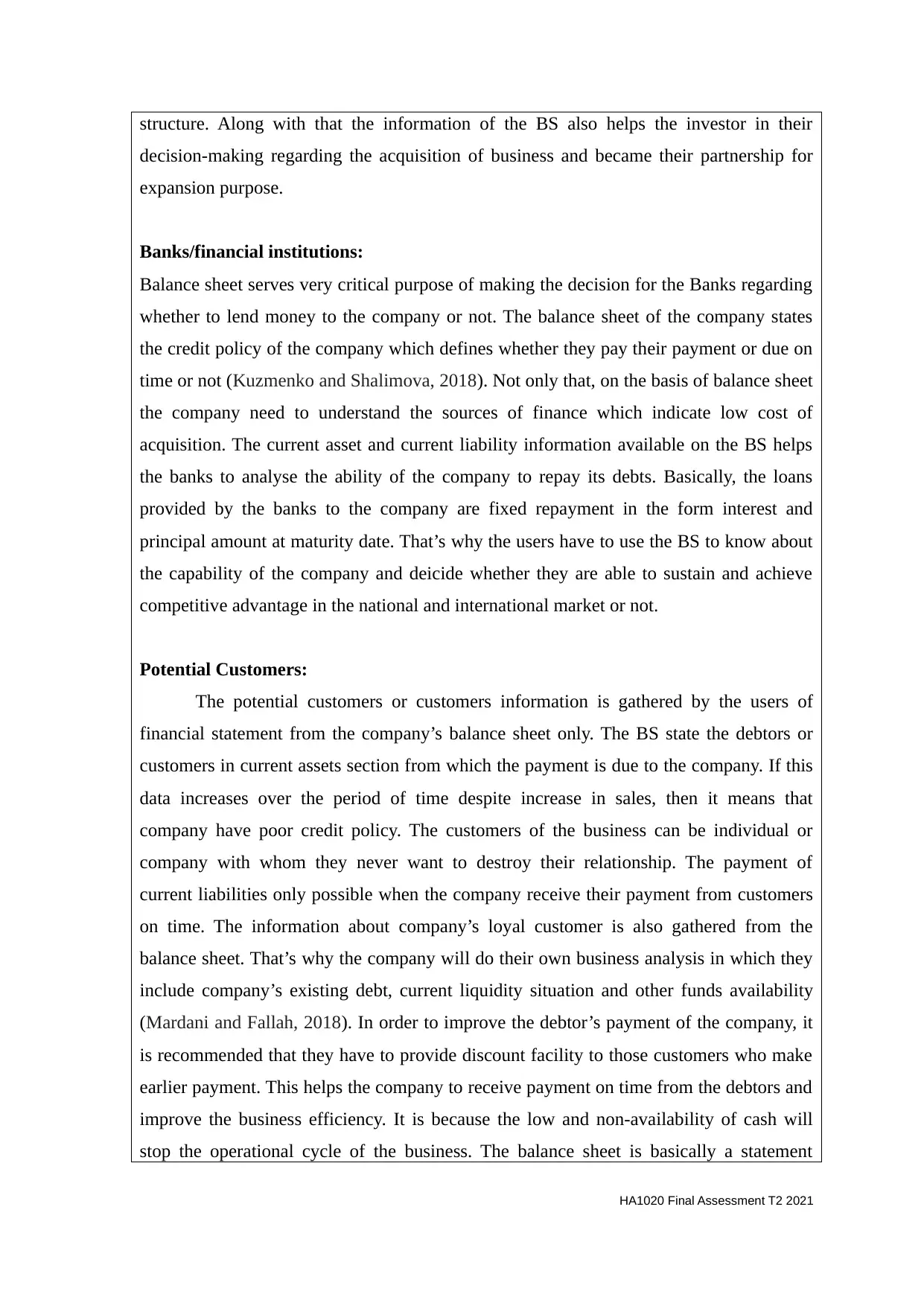
structure. Along with that the information of the BS also helps the investor in their
decision-making regarding the acquisition of business and became their partnership for
expansion purpose.
Banks/financial institutions:
Balance sheet serves very critical purpose of making the decision for the Banks regarding
whether to lend money to the company or not. The balance sheet of the company states
the credit policy of the company which defines whether they pay their payment or due on
time or not (Kuzmenko and Shalimova, 2018). Not only that, on the basis of balance sheet
the company need to understand the sources of finance which indicate low cost of
acquisition. The current asset and current liability information available on the BS helps
the banks to analyse the ability of the company to repay its debts. Basically, the loans
provided by the banks to the company are fixed repayment in the form interest and
principal amount at maturity date. That’s why the users have to use the BS to know about
the capability of the company and deicide whether they are able to sustain and achieve
competitive advantage in the national and international market or not.
Potential Customers:
The potential customers or customers information is gathered by the users of
financial statement from the company’s balance sheet only. The BS state the debtors or
customers in current assets section from which the payment is due to the company. If this
data increases over the period of time despite increase in sales, then it means that
company have poor credit policy. The customers of the business can be individual or
company with whom they never want to destroy their relationship. The payment of
current liabilities only possible when the company receive their payment from customers
on time. The information about company’s loyal customer is also gathered from the
balance sheet. That’s why the company will do their own business analysis in which they
include company’s existing debt, current liquidity situation and other funds availability
(Mardani and Fallah, 2018). In order to improve the debtor’s payment of the company, it
is recommended that they have to provide discount facility to those customers who make
earlier payment. This helps the company to receive payment on time from the debtors and
improve the business efficiency. It is because the low and non-availability of cash will
stop the operational cycle of the business. The balance sheet is basically a statement
HA1020 Final Assessment T2 2021
decision-making regarding the acquisition of business and became their partnership for
expansion purpose.
Banks/financial institutions:
Balance sheet serves very critical purpose of making the decision for the Banks regarding
whether to lend money to the company or not. The balance sheet of the company states
the credit policy of the company which defines whether they pay their payment or due on
time or not (Kuzmenko and Shalimova, 2018). Not only that, on the basis of balance sheet
the company need to understand the sources of finance which indicate low cost of
acquisition. The current asset and current liability information available on the BS helps
the banks to analyse the ability of the company to repay its debts. Basically, the loans
provided by the banks to the company are fixed repayment in the form interest and
principal amount at maturity date. That’s why the users have to use the BS to know about
the capability of the company and deicide whether they are able to sustain and achieve
competitive advantage in the national and international market or not.
Potential Customers:
The potential customers or customers information is gathered by the users of
financial statement from the company’s balance sheet only. The BS state the debtors or
customers in current assets section from which the payment is due to the company. If this
data increases over the period of time despite increase in sales, then it means that
company have poor credit policy. The customers of the business can be individual or
company with whom they never want to destroy their relationship. The payment of
current liabilities only possible when the company receive their payment from customers
on time. The information about company’s loyal customer is also gathered from the
balance sheet. That’s why the company will do their own business analysis in which they
include company’s existing debt, current liquidity situation and other funds availability
(Mardani and Fallah, 2018). In order to improve the debtor’s payment of the company, it
is recommended that they have to provide discount facility to those customers who make
earlier payment. This helps the company to receive payment on time from the debtors and
improve the business efficiency. It is because the low and non-availability of cash will
stop the operational cycle of the business. The balance sheet is basically a statement
HA1020 Final Assessment T2 2021

which described the assets, liabilities and shareholders equities of the company in a
particular date. On this basis, the various internal and external user take appropriate and
profitable decisions.
Raw material supplier/Creditors:
The raw material suppliers of the company are the one who provide then stocks for
converting them into finished products. The creditors supply the goods to the company on
both cash and credit basis. This creditor shown in balance sheet indicate that this much
amount yet due be paid by the supplier. The creditors will change over the period of time
but in case if creditors increase with the unchanged and slight change in purchase than it
means that the credit worthiness of the company is very poor (Omondi, 2021). This need
to be improved by the company otherwise creditors will not supply goods to the company
on credit basis. In order to improve it the company can either give payment on time or can
pay interest on late payment. The creditors are the users of company’s financial statement
which get affected by this information available in the balance sheet. Thus, in order to
improve it they have to adopt the above mentioned two solutions.
Government Agencies/ Banking and stock market regulators:
The information about business ethics and financial position of the company are
also gathered from the statement of financial position. This state whether the company are
able to pay its bank loan or other financial institution along with the fixed payment to
debts on time or not. Along with that the banker can also use the information for analysing
credit worthiness of the company because bankers always do business with the public
deposits (De Boer, 2021). In case, if they do not get their payment back various of public
deposits get vanished which lastly affect the large public only. The public invest their
money in bank by keeping trust which bank cannot harm and destroy. The stock regulator
keeps their eye on businesses to know whether all information is disclosed by the
company in their balance sheet or not. It is because management in order to improve their
business performance do window dressing which means manipulation of accounts and
statements.
Question 6 (7 marks)
HA1020 Final Assessment T2 2021
particular date. On this basis, the various internal and external user take appropriate and
profitable decisions.
Raw material supplier/Creditors:
The raw material suppliers of the company are the one who provide then stocks for
converting them into finished products. The creditors supply the goods to the company on
both cash and credit basis. This creditor shown in balance sheet indicate that this much
amount yet due be paid by the supplier. The creditors will change over the period of time
but in case if creditors increase with the unchanged and slight change in purchase than it
means that the credit worthiness of the company is very poor (Omondi, 2021). This need
to be improved by the company otherwise creditors will not supply goods to the company
on credit basis. In order to improve it the company can either give payment on time or can
pay interest on late payment. The creditors are the users of company’s financial statement
which get affected by this information available in the balance sheet. Thus, in order to
improve it they have to adopt the above mentioned two solutions.
Government Agencies/ Banking and stock market regulators:
The information about business ethics and financial position of the company are
also gathered from the statement of financial position. This state whether the company are
able to pay its bank loan or other financial institution along with the fixed payment to
debts on time or not. Along with that the banker can also use the information for analysing
credit worthiness of the company because bankers always do business with the public
deposits (De Boer, 2021). In case, if they do not get their payment back various of public
deposits get vanished which lastly affect the large public only. The public invest their
money in bank by keeping trust which bank cannot harm and destroy. The stock regulator
keeps their eye on businesses to know whether all information is disclosed by the
company in their balance sheet or not. It is because management in order to improve their
business performance do window dressing which means manipulation of accounts and
statements.
Question 6 (7 marks)
HA1020 Final Assessment T2 2021
⊘ This is a preview!⊘
Do you want full access?
Subscribe today to unlock all pages.

Trusted by 1+ million students worldwide
1 out of 14
Your All-in-One AI-Powered Toolkit for Academic Success.
+13062052269
info@desklib.com
Available 24*7 on WhatsApp / Email
![[object Object]](/_next/static/media/star-bottom.7253800d.svg)
Unlock your academic potential
Copyright © 2020–2025 A2Z Services. All Rights Reserved. Developed and managed by ZUCOL.

